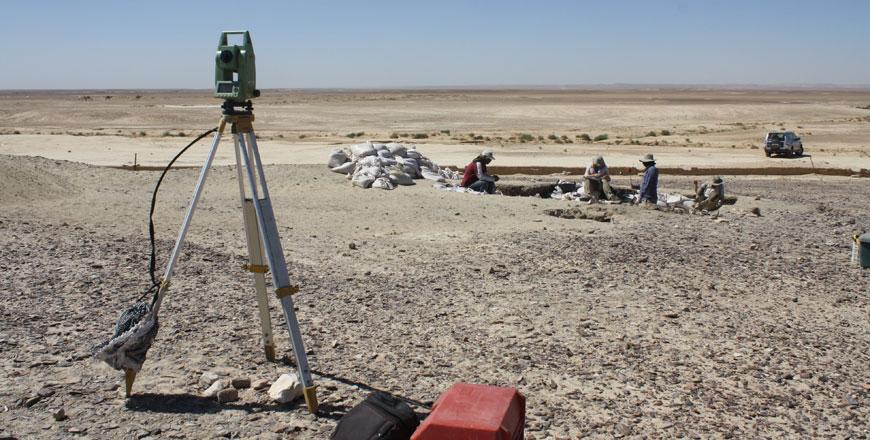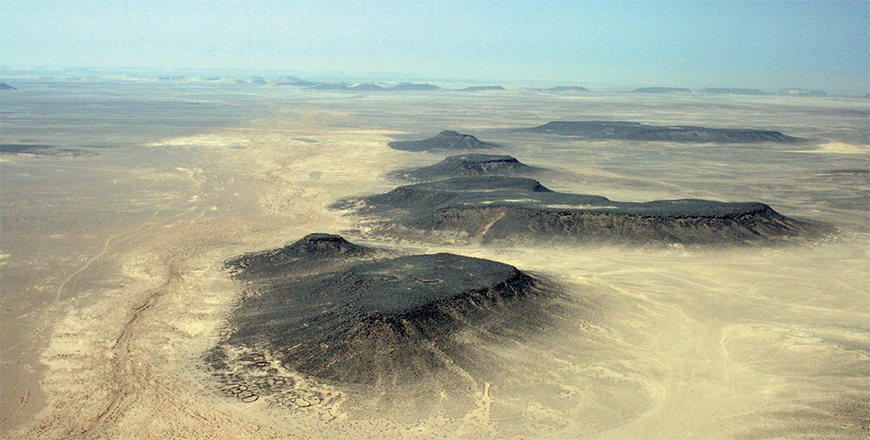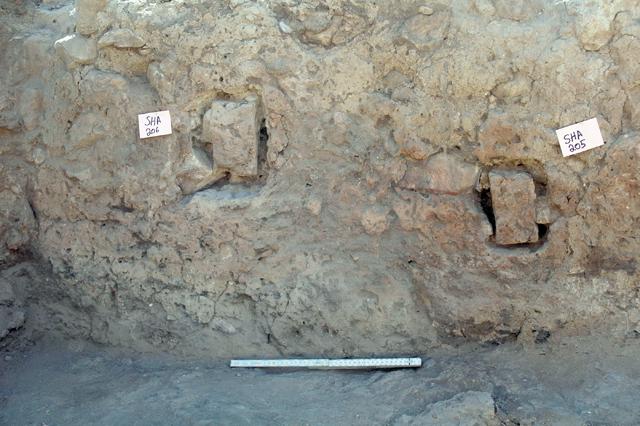You are here
Two American scholars analyse hunter-gatherer site of Kharaneh IV
By Saeb Rawashdeh - Jul 29,2018 - Last updated at Jul 29,2018

Archaeological team involved in the field work at Kharaneh site (Photo courtesy of Kharaneh IV project)
AMMAN — While older hypotheses believed that the developments from hunter-gatherers to Neolithic people used to be linear, new research based on recent excavations and advanced analytical techniques proved that the pathway to the Neolithic was not a linear process, said scholar Danielle Macdonald, who has been working on the Kharaneh IV project and comes from the University of Tulsa, Oklahoma.
“Early/Middle Epipalaeolithic sites like Kharaneh IV [some 60 kilometres east of Amman] show evidence of some of the ‘complex’ cultural traits previously associated with the Late Epipalaeolithic, such as long-distance trade and a symbolic connection to houses,” explained Lisa Maher, from The University of California, Berkeley, noting that Kharaneh IV is the largest Early/Middle Epipalaeolithic site found anywhere in the region.
“The site is very significant for our understanding of the Late Pleistocene in eastern Levant because of its large size and the density and diversity of material culture,” Macdonald explained, formulating the hypothesis that it was a hunter-gatherer aggregation site.
Kharaneh IV may have been a place where numerous hunter-gatherer groups from across the region would come together to interact, hunt gazelle and perform ritual activities, Maher underlined, noting that the site also shows the complexity of hunter-gatherer lives during the Early and Middle Epipalaeolithic
“We have discovered several hut structures at the site, the oldest in Jordan, that give us insight into how people were living in the past. These houses include utilitarian tools as well as symbolic objects like shell beads, suggesting that there was little separation between ritual and domestic life,” Macdonald commented.
“Over the course of our excavations we have found thousands of shell beads, most of which come from the Mediterranean or Red Seas, indicating that the people at Kharaneh IV had extensive trade networks,” she stressed.
“Most of the artefacts we found include stone tools, many used as projectiles for hunting animals like gazelle. We also discovered a lot of faunal remains [animal bones] that tell us about the animals that the people at Kharaneh IV hunted. They ate a lot of gazelle, but also hunted other animals such as aurochs [extinct wild cattle], foxes, hares, and birds,” Maher outlined.
Macdonald said the site also provides evidence that cultural patterns previously associated with later periods and the “Neolithic package” are actually present much earlier at sites like Kharaneh IV.
“We have obtained a large number of radiocarbon dates from charcoal samples that we have collected at the site. These dates show that Kharaneh IV was occupied for approximately 1,200 years, from 19,830-18,600 cal BP,” Maher underscored.
The continuous occupation throughout the stratigraphic sequences shows that people were returning to the site on a regular basis over 1,200 years, Macdonald continued, adding that this suggests that Kharaneh IV was an important place on the landscape for Epipalaeolithic people.
This summer, researchers from the Kharaneh IV project will resume excavations of the hut structures at the site. “We hope to gain a better understanding of how people were using their houses, what they were doing inside versus outside of the structures, and who might have been coming to the site. After the excavation is complete, we will work on analysing the artefacts from the structure,” Macdonald explained.
These analyses include stone tool analysis to identify what types of tools are found in the houses and how the tools are made. Back at the University of Tulsa, Danielle will analyse a selection of tools from the structure using microscopes to detect microscopic traces of wear on the tools’ surfaces, reconstructing how the stone tools were used in the past, Maher said, adding that Macdonald is also working with graduate students to compare the function of stone tools from Kharaneh IV with tools from across the region to understand different patterns of tool use during the Epipalaeolithic.
In the meantime, at Berkeley, Maher will train graduate and undergraduate students in stone tool analysis, as well as work on other aspects of material culture analysis, and analyse the microstratigraphic remains from the site to provide a detailed reconstruction of activities inside and outside of the structures.
“She will also be working with students to reconstruct the techniques and technologies involved in the construction of these hut structures, explore geochemical remains of human activity, and conduct stone tool production experiments to understand how these tools were made and used,” Macdonald concluded.
Related Articles
AMMAN — The eastern Black Desert is an area between modern Syria, Jordan and Saudi Arabia with plenty of evidence for the hunting activities
IRBID — Communal buildings in Sharara, a site located in Wadi Al Hasa which overlooks the southern part of the Dead Sea, during Pre-Pottery
AMMAN — Shubayqa, a site located some 130 kilometres northeast of Amman, represents a hunter-gatherer spot and as such it draws attention of














